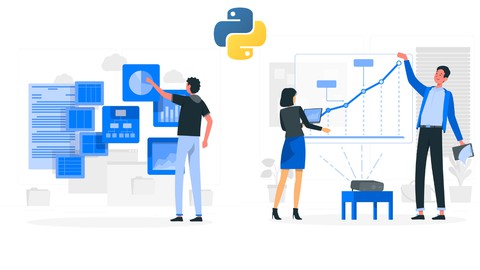
Data Visualization with Python and Project Implementation
Data Visualization with Python and Project Implementation, available at $19.99, has an average rating of 4.25, with 36 lectures, based on 55 reviews, and has 11746 subscribers.
You will learn about How to use Python for Data Visualization Full-fledged hands-on Project on Data Visualization with Python – "Visualizing Covid-19" How to develop useful, intuitive and informative visualizations using Python programming Introduction to Data Visualization – what it is, its importance & benefits Top Python Libraries for Data Visualization Introduction to Matplotlib, Install Matplotlib with pip Basic Plotting with Matplotlib NumPy and Pandas Data Visualization tools – Bar chart, Histogram, Pie chart More Data Visualization tools – Scatter Plot, Area Plot, Stacked Area Plot, Box Plot Advanced data Visualization tools – Waffle Chart, Word Cloud, Heat map Specialized data Visualization tools (I) – Bubble charts, Contour plots, Quiver Plot Specialized data Visualization tools (II) – 3D Plotting in Matplotlib 3D Line Plot, 3 D Scatter Plot, 3D Contour Plot, 3D Wireframe Plot, 3D Surface Plot Seaborn – Introduction to Seaborn, Seaborn functionalities, Installing Seaborn Different categories of plot in Seaborn, Some basic plots using seaborn Data Visualization using Seaborn – Strip Plot, Swarm Plot, Plotting Bivariate Distribution Scatter plot, Hexbin plot, KDE, Regplot, Visualizing Pairwise Relationship, Box plot, Violin Plots, Point Plot This course is ideal for individuals who are Data Analysts & Consultants or Python Programmers & Developers or Business Analysts & Consultants or Anyone wishing to make a career in Business Intelligence, Visualization and Analytics or Data Visualization Managers or Data Engineers & Data Scientists or Data Visualization Developers or Data Architects or Data Visualization Leads or Newbies and beginners aspiring to become BI & Visualization professionals or Data Analysts – Python, Tableau, SQL or BI Solutions Manager or Reporting Analysts or Machine Learning Professionals It is particularly useful for Data Analysts & Consultants or Python Programmers & Developers or Business Analysts & Consultants or Anyone wishing to make a career in Business Intelligence, Visualization and Analytics or Data Visualization Managers or Data Engineers & Data Scientists or Data Visualization Developers or Data Architects or Data Visualization Leads or Newbies and beginners aspiring to become BI & Visualization professionals or Data Analysts – Python, Tableau, SQL or BI Solutions Manager or Reporting Analysts or Machine Learning Professionals.
Enroll now: Data Visualization with Python and Project Implementation
Summary
Title: Data Visualization with Python and Project Implementation
Price: $19.99
Average Rating: 4.25
Number of Lectures: 36
Number of Published Lectures: 36
Number of Curriculum Items: 36
Number of Published Curriculum Objects: 36
Original Price: $19.99
Quality Status: approved
Status: Live
What You Will Learn
- How to use Python for Data Visualization
- Full-fledged hands-on Project on Data Visualization with Python – "Visualizing Covid-19"
- How to develop useful, intuitive and informative visualizations using Python programming
- Introduction to Data Visualization – what it is, its importance & benefits
- Top Python Libraries for Data Visualization
- Introduction to Matplotlib, Install Matplotlib with pip
- Basic Plotting with Matplotlib
- NumPy and Pandas
- Data Visualization tools – Bar chart, Histogram, Pie chart
- More Data Visualization tools – Scatter Plot, Area Plot, Stacked Area Plot, Box Plot
- Advanced data Visualization tools – Waffle Chart, Word Cloud, Heat map
- Specialized data Visualization tools (I) – Bubble charts, Contour plots, Quiver Plot
- Specialized data Visualization tools (II) – 3D Plotting in Matplotlib
- 3D Line Plot, 3 D Scatter Plot, 3D Contour Plot, 3D Wireframe Plot, 3D Surface Plot
- Seaborn – Introduction to Seaborn, Seaborn functionalities, Installing Seaborn
- Different categories of plot in Seaborn, Some basic plots using seaborn
- Data Visualization using Seaborn – Strip Plot, Swarm Plot, Plotting Bivariate Distribution
- Scatter plot, Hexbin plot, KDE, Regplot, Visualizing Pairwise Relationship, Box plot, Violin Plots, Point Plot
Who Should Attend
- Data Analysts & Consultants
- Python Programmers & Developers
- Business Analysts & Consultants
- Anyone wishing to make a career in Business Intelligence, Visualization and Analytics
- Data Visualization Managers
- Data Engineers & Data Scientists
- Data Visualization Developers
- Data Architects
- Data Visualization Leads
- Newbies and beginners aspiring to become BI & Visualization professionals
- Data Analysts – Python, Tableau, SQL
- BI Solutions Manager
- Reporting Analysts
- Machine Learning Professionals
Target Audiences
- Data Analysts & Consultants
- Python Programmers & Developers
- Business Analysts & Consultants
- Anyone wishing to make a career in Business Intelligence, Visualization and Analytics
- Data Visualization Managers
- Data Engineers & Data Scientists
- Data Visualization Developers
- Data Architects
- Data Visualization Leads
- Newbies and beginners aspiring to become BI & Visualization professionals
- Data Analysts – Python, Tableau, SQL
- BI Solutions Manager
- Reporting Analysts
- Machine Learning Professionals
A warm welcome to the Data Visualization with Python and Project Implementationcourse by Uplatz.
Data Visualizations allow humans to explore data in many different ways and see patterns and insights that would not be possible when looking at the raw form. Humans crave narrative and visualizations allow us to pull a story out of our stores of data. Data visualization is the discipline of trying to understand data by placing it in a visual context so that patterns, trends and correlations that might not otherwise be detected can be exposed.
As datasets become bigger and more complex, only AI, materialized views, and more sophisticated coding languages will be able to glean insights from them. Advanced analytics is paving the way for the next wave of innovation.The human brain processes visual data better than any other kind of data, which is good because most of the information our brains process is visual. Visual processing and responses both occur more quickly compared to other stimuli.
A good visualization could be the difference between hard to digest piles of data and useful business information. With increasing volume of data, it is next to impossible to rely on just one way frequency tables and statistics to understand the data. Good visualizations can accelerate the process of understanding data and gaining insights.
Why Python for Data Visualization?
Python offers multiple great graphing libraries that come packed with lots of different features. No matter if you want to create interactive, live or highly customized plots python has an excellent library for you.
Python programming language has different types of libraries for all kind of projects. Likewise, python has various libraries for visualization of Data, so that user can understand the dataset in very detailed way and analyze it properly.
Each library of visualization has its own specification. Using the particular libraries for specific task helps the user to complete the task in more easy and accurate way. Some liberates work better than the others.
Python uses two exclusive libraries for data visualization.
Matplotlib
Python based plotting library offers matplotlib with a complete 2D support along with limited 3D graphic support. It is useful in producing publication quality figures in interactive environment across platforms. It can also be used for animations as well. Matplotlib is a library used for plotting graphs in the Python programming language. It is used plot 2 – dimensional arrays. Matplotlib is built on NumPy arrays. It is designed to work with the border SciPy stack. It was developed by John Hunter in 2002. The benefit of visualization is that user can have visual access to large amounts of the dataset. Matplotlib is a library which is consists of various plots such as histogram, bar, line, scatter, etc. Matplotlib comes with a huge variety of plots. Plots are helpful for understanding patterns, trends and for making correlations. It has instruments for reasoning about quantitative information. As matplotlib was the very first library of data visualization in python, many other libraries are developed on top of it or designed to work parallel to it for the analysis of the dataset.
Seaborn
Seaborn is a library for creating informative and attractive statistical graphics in python. This library is built on top of the Matplotlib library. Seaborn offers various features such as built in themes, color palettes, functions and tools to visualize univariate, bivariate, linear regression, matrices of data, statistical time series etc. that allows us to build complex visualizations. Seaborn is a library of Python programming basically used for making statistical graphics of the dataset. It is also integrated closely with Pandas, which is used for the data structure of Datasets. Seaborn is very helpful to explore and understand data in a better way. It provides a high level of a crossing point for sketching attractive and informative algebraic graphics.
Some of the other key Python libraries used in data visualization are:
-
Pandas visualization – easy to use interface, built on Matplotlib
-
Ggplot – based on R’s ggplot2, uses Grammar of Graphics
-
Pygal
-
Missingno
-
Plotly – can create interactive plots
-
Gleam
-
Leather
-
Geoplotlib
-
Bokeh
-
Folium
Uplatzoffers this complete course on Data Visualization with Python. This Data Visualization in Python course will help you use Python’s most popular and robust data visualization libraries. Learn how to use Matplotlib, Seaborn, Bokeh, and others to create useful static and interactive visualizations of categorical, aggregated, and geospatial data.
Data Visualization with Python – Course Syllabus
1. Introduction to Data Visualization
-
What is data visualization
-
Benefits of data visualization
-
Importance of data visualization
-
Top Python Libraries for Data Visualization
2. Matplotlib
-
Introduction to Matplotlib
-
Install Matplotlib with pip
-
Basic Plotting with Matplotlib
-
Plotting two or more lines on the same plot
3. Numpy and Pandas
-
What is numpy?
-
Why use numpy?
-
Installation of numpy
-
Example of numpy
-
What is a panda?
-
Key features of pandas
-
Python Pandas – Environment Setup
-
Pandas – Data Structure with example
4. Data Visualization tools
-
Bar chart
-
Histogram
-
Pie Chart
5. More Data Visualization tools
-
Scatter Plot
-
Area Plot
-
STACKED Area Plot
-
Box Plot
6. Advanced data Visualization tools
-
Waffle Chart
-
Word Cloud
-
HEAT MAP
7. Specialized data Visualization tools (Part-I)
-
Bubble charts
-
Contour plots
-
Quiver Plot
8. Specialized data Visualization tools (Part-II)
Three-Dimensional Plotting in Matplotlib
-
3D Line Plot
-
3D Scatter Plot
-
3D Contour Plot
-
3D Wireframe Plot
-
3D Surface Plot
9. Seaborn
-
Introduction to seaborn
-
Seaborn Functionalities
-
Installing seaborn
-
Different categories of plot in Seaborn
-
Some basic plots using seaborn
10. Data Visualization using Seaborn
-
Strip Plot
-
Swarm Plot
-
Plotting Bivariate Distribution
-
Scatter plot, Hexbin plot, KDE, Regplot
-
Visualizing Pairwise Relationship
-
Box plot, Violin Plots, Point Plot
11. Project on Data Visualization
Course Curriculum
Chapter 1: Introduction to Data Visualization
Lecture 1: Introduction to Data Visualisation
Chapter 2: Matplotlib
Lecture 1: Matplotlib – part 1
Lecture 2: Matplotlib – part 2
Chapter 3: NumPy and Pandas
Lecture 1: NumPy and Pandas – part 1
Lecture 2: NumPy and Pandas – part 2
Lecture 3: NumPy and Pandas – part 3
Chapter 4: Data Visualization Tools
Lecture 1: Data Visualisation Tools – part 1
Lecture 2: Data Visualisation Tools – part 2
Lecture 3: Data Visualisation Tools – part 3
Chapter 5: More Data Visualization Tools
Lecture 1: More Data Visualisation Tools – part 1
Lecture 2: More Data Visualisation Tools – part 2
Lecture 3: More Data Visualisation Tools – part 3
Chapter 6: Advanced Data Visualization Tools
Lecture 1: Advanced Data Visualisation Tools – part 1
Lecture 2: Advanced Data Visualisation Tools – part 2
Lecture 3: Advanced Data Visualisation Tools – part 3
Chapter 7: Specialized Data Visualization Tools (I)
Lecture 1: Specialized Data Visualisation Tools (I) – part 1
Lecture 2: Specialized Data Visualisation Tools (I) – part 2
Lecture 3: Specialized Data Visualisation Tools (I) – part 3
Chapter 8: Specialized Data Visualization Tools (II)
Lecture 1: Specialized Data Visualisation Tools (II) – part 1
Lecture 2: Specialized Data Visualisation Tools (II) – part 2
Lecture 3: Specialized Data Visualisation Tools (II) – part 3
Lecture 4: Specialized Data Visualisation Tools (II) – part 4
Chapter 9: Seaborn
Lecture 1: Seaborn – part 1
Lecture 2: Seaborn – part 2
Lecture 3: Seaborn – part 3
Chapter 10: Data Visualization using Seaborn
Lecture 1: Data Visualisation using Seaborn – part 1
Lecture 2: Data Visualisation using Seaborn – part 2
Lecture 3: Data Visualisation using Seaborn – part 3
Lecture 4: Data Visualisation using Seaborn – part 4
Lecture 5: Data Visualisation using Seaborn – part 5
Chapter 11: Project on Data Visualization with Python
Lecture 1: Project on Data Visualisation with Python – part 1
Lecture 2: Project on Data Visualisation with Python – part 2
Lecture 3: Project on Data Visualisation with Python – part 3
Lecture 4: Project on Data Visualisation with Python – part 4
Lecture 5: Project on Data Visualisation with Python – part 5
Lecture 6: Project on Data Visualisation with Python – part 6
Instructors
-
Uplatz Training
Fastest growing global Technology & Cloud Training Provider
Rating Distribution
- 1 stars: 2 votes
- 2 stars: 1 votes
- 3 stars: 9 votes
- 4 stars: 20 votes
- 5 stars: 23 votes
Frequently Asked Questions
How long do I have access to the course materials?
You can view and review the lecture materials indefinitely, like an on-demand channel.
Can I take my courses with me wherever I go?
Definitely! If you have an internet connection, courses on Udemy are available on any device at any time. If you don’t have an internet connection, some instructors also let their students download course lectures. That’s up to the instructor though, so make sure you get on their good side!
You may also like
- Best Video Editing Courses to Learn in February 2025
- Best Music Production Courses to Learn in February 2025
- Best Animation Courses to Learn in February 2025
- Best Digital Illustration Courses to Learn in February 2025
- Best Renewable Energy Courses to Learn in February 2025
- Best Sustainable Living Courses to Learn in February 2025
- Best Ethical AI Courses to Learn in February 2025
- Best Cybersecurity Fundamentals Courses to Learn in February 2025
- Best Smart Home Technology Courses to Learn in February 2025
- Best Holistic Health Courses to Learn in February 2025
- Best Nutrition And Diet Planning Courses to Learn in February 2025
- Best Yoga Instruction Courses to Learn in February 2025
- Best Stress Management Courses to Learn in February 2025
- Best Mindfulness Meditation Courses to Learn in February 2025
- Best Life Coaching Courses to Learn in February 2025
- Best Career Development Courses to Learn in February 2025
- Best Relationship Building Courses to Learn in February 2025
- Best Parenting Skills Courses to Learn in February 2025
- Best Home Improvement Courses to Learn in February 2025
- Best Gardening Courses to Learn in February 2025






















